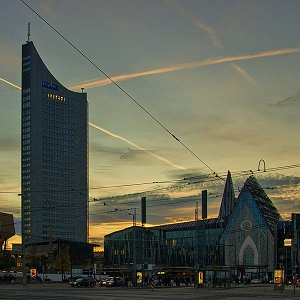
Like us on Facebook
PLACE NAMES


 
|
|
Leipzig
|

| |
|
|
Leipzig lies at the confluence of the rivers White Elster, Pleisse, and Parthe, in the Leipzig Bay, on the most southerly part of the North German Plain, which is the part North European Plain in Germany. The site is characterized by swampy areas such as the Leipzig Riverside Forest, though there are also some limestone areas to the north of the city. The landscape is mostly flat though there is also some evidence of moraine and drumlins.
Although there are some forest parks within the city limits, the area surrounding Leipzig is relatively unforested. During the 20th century, there were a several open-cast mines in the region, many of which are being converted to use as lakes.
Leipzig is also situated at the intersection of the ancient roads known as the Via Regia (King's highway), which traversed Germanic lands in an east-west direction, and Via Imperii (Imperial Highway), a north-south road.
Leipzig was a walled city in the Middle Ages and the current "ring" road around the historic center of the city corresponds to the old city walls.
Leipzig is a city in the federal state of Saxony, Germany. It has around 540,000 inhabitants and is the heart of the Central German Metropolitan Region. Leipzig is located about 150 kilometres (93 miles) south of Berlin.
Leipzig has been a trade city, since, at least the time of the Holy Roman Empire, sitting at the intersection of two important Medieval trade routes. At one time, Leipzig was one of the major European centers of learning and culture in fields such as music and publishing. After World War II, Leipzig became a major urban center within the German Democratic Republic (East Germany), but its cultural and economic importance declined, despite East Germany being the richest economy in the Soviet Bloc.
Leipzig later played a significant role in instigating the fall of communism in Eastern Europe, through events which took place in and around St. Nicholas Church. Since the reunification of Germany, Leipzig has undergone significant change with the restoration of some historical buildings, the demolition of others, and the development of a modern transport infrastructure. Leipzig today is an economic center in Germany and has a prominent opera house and one of the most modern zoos in Europe. Leipzig is nicknamed as the "Boomtown of eastern Germany" or "Hypezig".
In December 2013, according to a study by Marktforschungsinstituts GfK, Leipzig was ranked as the most livable city in Germany and is one of the three European cities with the highest quality of living (after Groningen and Kraków). In 2010, Leipzig was included in the top 10 cities to visit by the New York Times, and ranked 39th globally out of 289 cities for innovation in the 4th Innovation Cities Index published by Australian agency 2thinknow.
Leipzig is derived from the Slavic word Lipsk, which means "settlement where the linden trees (British English: lime trees; U.S. English: basswood trees) stand". An older spelling of the name in English is Leipsic. The Latin name Lipsia was also used.
In 1937 the Nazi government officially renamed the city Reichsmessestadt Leipzig (Imperial Trade Fair City Leipzig).
More recently, the city is sometimes nicknamed Hypezig for being celebrated by the media as a hip urban center for the creative scene.
|
 Feel free to Email me any additions or corrections Feel free to Email me any additions or corrections
LINKS AVAILABLE TO YOUR SITE
| |





